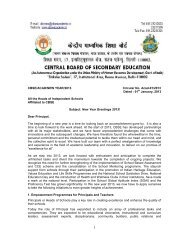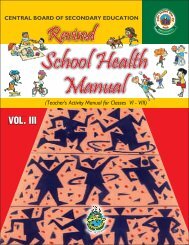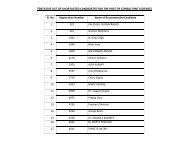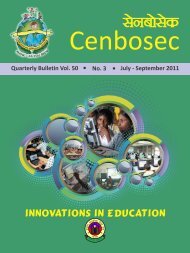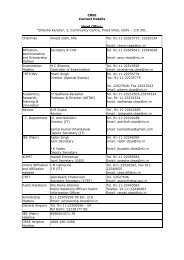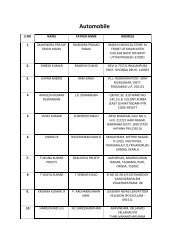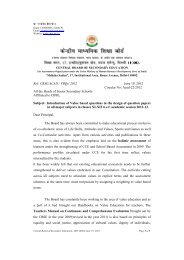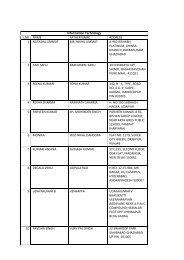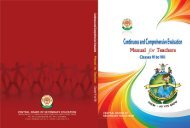to view or download - CBSE
to view or download - CBSE
to view or download - CBSE
- No tags were found...
Create successful ePaper yourself
Turn your PDF publications into a flip-book with our unique Google optimized e-Paper software.
CENTRAL BOARD OF SECONDARY EDUCATIONINSTITUTIONAL AREA, ROUSE AVENUE, NEW DELHI-110002<strong>CBSE</strong>/ACAD/CIRCULAR/2007 14th March,2007Circular No. 17All Heads of InstitutionsAffiliated <strong>to</strong> <strong>CBSE</strong>.Subject : Imp<strong>or</strong>tance of Nutrition f<strong>or</strong> Bone Health.Dear Principal,Bone Health is a neglected area and has resulted in various problems both f<strong>or</strong> adults and youngchildren.The maj<strong>or</strong> causes f<strong>or</strong> the po<strong>or</strong> bone health in India are genetic predisposition, lower bone mineraldensity due <strong>to</strong> deficiency of calcium and vitamin D, inadequate exposure of body surface area <strong>to</strong>direct sunshine even though the country has plenty of sunshine throughout the year, clothing pattern,relatively pigmented skin, po<strong>or</strong> diet, lack of availability of foods f<strong>or</strong>tified with essential vitamins andminerals and lack of physical activity.Childhood and adolescence is the time when bones are beginning <strong>to</strong> be modeled until around the ageof 30 when peak bone mass is achieved. Diet in the modeling phase is extremely imp<strong>or</strong>tant. Acritical element that helps abs<strong>or</strong>b deposition of dietary calcium in<strong>to</strong> bone mass is vitamin D. Deficiencyof vitamin D is one of maj<strong>or</strong> contribu<strong>to</strong>ry fac<strong>to</strong>r responsible f<strong>or</strong> lower bone mineral density(BMD).A related bone problem is flurosis. It is prevalent in 17 States and has affected 66 million peopleincluding about 6 million children below the age of 14. It results from consuming ground water withexcessive flu<strong>or</strong>ide leading <strong>to</strong> bone dis<strong>or</strong>ders. Inadequate exposure of body surface area <strong>to</strong> directsunshine, clothing pattern, relatively pigmented skin, environmental pollution, faulty housing architecturewhich does not allow enough sunshine, po<strong>or</strong> diet and lack of required food f<strong>or</strong>tification, areamong the maj<strong>or</strong> fac<strong>to</strong>rs responsible f<strong>or</strong> compromised bone health.It is imp<strong>or</strong>tant <strong>to</strong> pay attention <strong>to</strong> bone health right f<strong>or</strong> childhood. It is in this regard, schools may beadvised <strong>to</strong> take steps regarding the following aspects :1. Schools should promote outdo<strong>or</strong> physical activity after 9.00 a.m. and bef<strong>or</strong>e 4.00 p.m. f<strong>or</strong>adequate exposure <strong>to</strong> sunshine. Sunshine is the most imp<strong>or</strong>tant source of vitamin D.Vitamin. D helps abs<strong>or</strong>ption of calcium. The main source of vitamin D is the exposure <strong>to</strong>sunlight. Exposure of legs and arms <strong>to</strong> sunlight f<strong>or</strong> about 25 minutes between 9 AM and 4PM is adequate.Physical activity at all ages, particularly weight bearing activity, is imp<strong>or</strong>tant f<strong>or</strong> bonehealth. It also reduces the risk of falling by strengthening muscles and maintaining balance.Calcium is critical f<strong>or</strong> sound bone health. Foods containing calcium like milk, leafy greenvegetables, etc. should be a part of the n<strong>or</strong>mal daily diet.69





